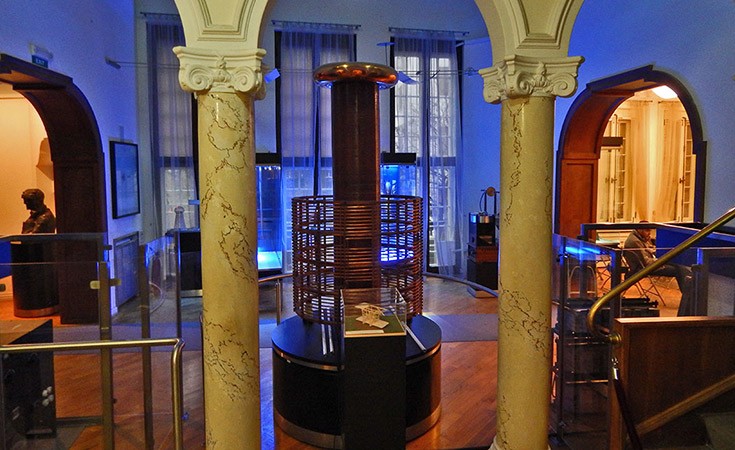
Museum of Nikola Tesla
The Museum of Nikola Tesla in Belgrade is dedicated to one of the most important world scientists, a man who, according to some, invented the 20th century, mechanical and electrical engineer who thanks to his inventions changed the world and laid foundations for later scientific accomplishments. Nikola Tesla was born on the January 10th, 1856 in the village Smiljan located on the border of once large Austrian-Hungarian Empire. Actually, Serbian families fled their lands on different occasions in front of the ferocities of the Turks who occupied the area of modern Serbia, and by accepting to protect the border and fight against the Turks, they were allowed to live in the Austrian-Hungarian Empire. The fact he was not born in Serbia gave rise to a hurry of some countries to proclaim Tesla as their own due to his importance as a scientist. Tesla’s father, Milutin, a priest in the Serbian Orthodox Church, owned a large collection of books, which Nikola used already in his early youth in order to study and learn new languages. Nikola went to the elementary school and high school in his birthplace Smiljan and Gospici. Two years after the graduation, he left to Graz in Austria in order to study electrical engineering. Before Tesla left for the United States, he had worked in Budapest (Hungary) and Paris (France). Tesla arrived to the United States in 1884 and started working in the laboratory of Thomas Edison. Nikola patented a large number of his inventions regarding DC generators, electrical engines and current transformers (CT). He also invented Tesla’s transformer which is used in television sets and radio equipemnet. He also invented wireless communications, wireless transfer of electricity, remote control, robotics, Tesla’s turbine and numerous other inventions. He played a key role in the construction of the first hydroelectric plant on the Niagara Falls. After his death on January 7th 1943 in New York, by the decision of the United States Authorities all of Tesla’s property (including his drawings and sketches) was given to Tesla’s relative Sava Kosanovic. According to Tesla’s wish, all of his property and work was transferred to Belgrade in 1951. The Museum of Nikola Tesla is located in Krunska Street in Belgrade, in a beautiful villa constructed in 1929. This museum is a unique scientific institution in Serbia as well as in the world. It is the only museum in the world which preserves the original inheritance of one of the most important world scientists. Thosevaluable collections include: Over 160,000 original documents Over 2,000 books and magazines Over 1,200 historical technical devices Over 1,500 photos, original glass photo-panels, technical objects and instruments Over 1,000 projects and blueprints In the museum of Nikola Tesla, visitors will be able to enjoy the museum’s permanent exhibition, which is divided into sections dedicated to Tesla’s life and work and another dedicated to the development of the electricity and magnetism.
Muzej Nikola Tesla posvećen je jednom od najvećih svetskih naučnika, čoveku za koga kažu da je "izumeo 20. vek", pronalazaču oko 700 svetski priznatih patenata, mašinskom i elektro inženjeru koji je svojim izumima promenio svet i postavio temelje za kasnija naučna dostignuća. Nikola Tesla rođen je 10. jula 1856. godine u selu Smiljan u nekadašnkoj Vojnoj krajini Austrijskog carstva. Teslin otac Milutin, inače sveštenik u Srpskoj pravoslavnoj crkvi, posedovao je bogatu biblioteku u kojoj je Nikola još od ranog uzrasta provodio vreme čitajući i učeći strane jezike. Osnovnu školu pohađao je u rodnom Smiljanu i Gospiću gde završava i gimnaziju. Dve godine nakon mature odlazi u Grac na studije elektrotehnike. Do odlaska u Sjedinjene Američke Države Tesla je radio i stvarao u Budimpešti i Parizu. Tesla u SAD boravi od 1884 godine kada dolazi da radi u laboratoriji Tomasa Edisona. Tesla je razvio veliki broj patenata za naizmenične generatore, motore i transformatore. Izmislio je Teslin transformator koji se koristi u radijskim i televizijskim uređajima, kao i fluorescentnu rasvetu, lasere, bežičnu komunikaciju, bežični prenos energije, daljinsko upravljanje, robotiku, Teslinu turbinu i mnoge druge pronalaske. Odigrao je ključnu ulogu u izgradnji prve hidrocentrale na Nijagarinim vodopadima. Nakon Tesline smrti 7. januara 1943. godine u Njujorku, odlukom Američkih vlasti sva Teslina zaostavština pripala je njegovom rođaku Savi Kosanoviću koji po Teslinoj želji svu njegovu ličnu imovinu i dokumentaciju prenosi u Beograd 1951. godine. Muzej Nikole Tesle smešten je u Ulici Krunskoj u velelepnoj vili izgrađenoj 1929. godine. Zgrada je imala razne namene sve do 1952. godine kada je osnovan muzej u čijem se posedu nalazi bogata arhivska građa o životu i radu slavnog srpskog naučnika. Muzej je jedinstvena institucija nauke i kulture u Srbiji, kao i u svetu. Jedini je muzej koji čuva originalnu i ličnu zaostavštinu Nikole Tesle. Poseduje izuzetno vredne kolekcije: preko 160.000 originalnih dokumenata; preko 2000 knjiga i časopisa; preko 1200 istorijsko-tehničkih eksponata; preko 1500 fotografija i staklenih fotoploča originalnih tehničkih predmeta, instrumenata i uredjaja; preko 1000 planova i crteža. Muzej ima stalnu postavku; prvi deo je posvećen Teslinom životu i radu, a u drugom je predstavljen razvoj nauke o elektricitetu i magnetizmu. Najzanimljiviji deo je svakako deo sa autentičnom dokumentacijom i radnim modelima Teslinih izuma. (!) U toku dana na početak svakog sata se organizuje vođena tura (na srpskom ili na engleskom jeziku u zavisnosti od sata). Ture se ne doplaćuju posebno, a bićete u mogućnosti da čujete i vidite Tesline eksperimente u primeni, da drzite neonsku lampu u ruci dok se struja bežično kreće kroz sobu, kroz vas, i skoro magično napaja lampu u vašoj ruci. U Muzeju Nikole Tesle nalazi se i urna sa Teslinim posmrtnim pepelom. Ona je smeštena u trećoj prostoriji muzeja, u pozlaćenoj kugli na kamenom postolju. Teslini posmrtni ostaci kremirani su u Njujorku, a 1957. godine prenešeni u Beograd.
see location here : link
